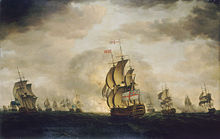John Peyton (Royal Navy officer)
John Peyton | |
|---|---|
 John Peyton | |
| Born | 1752 Ardingly, Sussex |
| Died | 2 August 1809 (aged 56–57) Lymington |
| Buried | |
| Allegiance | Rear-admiral |
John Goodwin Gregory Peyton (1752 – 2 August 1809) was an officer in the
Early life and career

John Goodwin Gregory Peyton was born in Ardingly, Sussex in 1752 to Joseph Peyton and his wife Katherine. The Peytons were a naval family; at least five generations served and both his grandfather, Edward Peyton and his father attained the rank of admiral.[1] John was one of seven children, five boys and two girls, and of his four brothers, all but one entered the Royal Navy: The eldest, named after his father, also became an admiral, the younger brother, William was an administrator, the youngest, Thomas, died while in command of HMS Monarch in 1801.[2]
Peyton's early career is not well documented, and he is sometimes confused with other family members, but it is most likely that he is the Peyton registered aboard his father's ship, HMS Belleisle, in 1766. Promoted to lieutenant in 1772, he remained with his father, fighting in HMS Cumberland at the first Battle of Cape St Vincent in 1780.[1]
Command
Peyton's first command was the 12-gun cutter,
At some point in 1795, Peyton took command of
Peyton was destined to become one of
Vanguard left England on 9 April 1798 and joined the
On 13 August, Peyton wrote a letter to his wife which gives one of the few surviving first-hand accounts of the Nile battle.[9]
Later life
Peyton retired to Lymington in 1800, where he bought Priestlands, a large house with extensive grounds. He lived there with his wife, Susanna Gurnell, whom he had married in 1793, until his death, at the age of 56, on 2 August 1809. There is a memorial to him at All Saints Church, Milford on Sea.[9]
Citations
References
- Clarke, James Stainer; MacArthur, John (1810). The Life of Admiral Lord Nelson KB. London: T. Cadell & W. Davies. OCLC 183096009.
- Hore, Peter (2015). Nelson's Band of Brothers: Lives and Memorials. Barnsley.: Seaforth Publishing. ISBN 9781848327795.
- ISBN 0-85177-906-9.
- Marshall, John (1828). Royal Naval Biography. London: Longman, Rees, Orme, Brown and Green. OCLC 1111834724.
- Winfield, Rif (2007). ISBN 978-1-84415-700-6.
- Winfield, Rif (2008). British Warships in the Age of Sail 1793–1817: Design, Construction, Careers and Fates. Barnsley: Seaforth. ISBN 978-1-86176-246-7.
